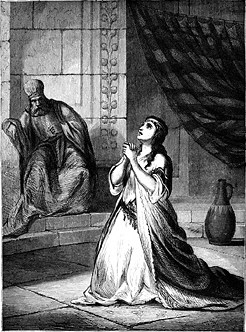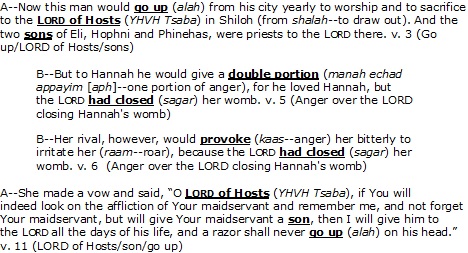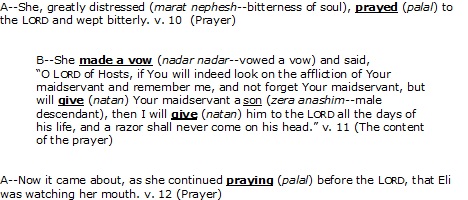
CHIASM, 1 SAMUEL 1:3-11

CHIASM 1 SAMUEL 1:10-12

Explaining Prayer and the Chiasms
- The Purpose of Man–when God created the heavens and the earth, they were formless and void (tohu va bohu). From this state of chaos, God ordered the universe by a series of utterances–“God said” (vayomer Elohim, 7 times), “God called” (vayikra Elohim, 3 times) and “God made/created” (vay-yaas Elohim; vay-yibra Elohim; 5 times). In verse 1:26, God said “Let us make man in our own image, according to our likeness.” The “image of God” is “tselem Elohim.” Tselem in Hebrew is a “representation” of someone or something, and is often translated into English as “idol.” It is spelled tsade-lamed-mem which pictographically means “the desire to control chaos.” Likeness in Hebrew is demut, spelled dalet-mem-tav. Pictographically, it means a door through which truth enters in the midst of chaos. We were created in the image and likeness of God so that we could serve as representatives of God, doors through which truth enters the world. And Scripture links this immediately to a purpose in verses 1:26 and 1:28 whereby man will have dominion (radah) over all creatures of the earth. This is the purpose for which man was created in the beginning. God works through man, as His representative, to bring and maintain order upon the Earth. As God’s representatives on Earth, we align to His purpose for us. Since God does not change, His purpose for mankind does not change. As we will see, this has an interesting connection to our understanding of prayer.
- God’s Actions. There are two ways in which we conceptualize God’s actions. One is that we look upon God as acting “unilaterally.” God, for instance, created the heavens and the earth, all on His own. God “confounded” the language of the world at the Tower of Babel, all on His own. God parted the Red Sea, and later the Jordan river, all on His own. God fed His people manna in the wilderness, all on His own. So, we know that God can act unilaterally. There are also occasions in which God acts through human beings. He worked through the Patriarchs–Abraham, Isaac and Jacob–to bring a people into existence that would make His name great upon the earth. He worked through Moses to rescue His people from slavery in Egypt, and to present His instruction, His Torah, to this people. He worked on numerous occasions to rescue His people by sending judges to redeem them from foreign rule. He worked through the tribe of Judah to bring forth kings, and over a number of generations of this tribe’s descendants, He brought forth Jesus, the Messiah. And through Paul, He brought His great message of salvation and redemption to the Gentiles. As much as we know that God can act on His own, unilaterally, we also know that He works through people to accomplish His will.
How does this information connect to prayer? Let’s start by asking: “What is it to pray?” The English word, prayer, has a Latin root, precari. It means to entreat or ask for something. This relates to two words in Scripture, techinnah in Hebrew and deaysis in Greek, meaning supplication, humbly asking for something, expressing a heartfelt need or making a petition to a higher authority. This often connects to our perception of God’s action in the world. People make supplications to God, feeling helpless, and crying out, calling upon (or making petitions to) God to take unilateral action on their behalf absent any action on their own. Supplication finds support in both Testaments. During the period of the Judges, the Israelites cried out (tsaaq) to God on numerous occasions to free them from foreign oppression. (Judges 3:9, 15; 4:3; 6:6, 7; 10:10) James famously said: “The deaysis of a righteous man can accomplish much.” (James 5:16)
Are prayer and supplication identical? Consider this. When King Solomon dedicated the Temple, he stated: “When Your people go out to battle against their enemy, by whatever way You shall send them, and they pray (palal) to the LORD toward the city which You have chosen and the house which I have built for Your name, then hear from heaven their prayer (palal) and their supplication (techinnah), and uphold their cause.” (1 Kings 8:44-45) Take note that King Solomon used the phrase “their prayer and their supplication”, using two different Hebrew words, thus indicating that prayer and supplication are not necessarily identical. Paul makes a similar distinction in the Book of Philippians: “Be anxious for nothing, but in every situation, by prayer (prosyookay) and supplication (deaysis), with thanksgiving, present your requests to God.” (Phil. 4:6) Why the distinction? The reason is that supplication is a form of prayer, but prayer is not a form of supplication.
While we may ask or entreat God to act unilaterally, He may not respond to our supplications unilaterally. Supplication has become a paradigm for prayer in many quarters. And this paradigm, while effective in many respects, narrows our vision and understanding on what prayer is. If prayer is not universally supplication, what then is it?
The most frequently used word in Hebrew for prayer is “tephillah.” The Hebrew root of this word is “palal” which means “to judge oneself.”[1] The first use of palal in the Scriptures occurs in Genesis, Chapter 20, in which God appeared to King Abimelech of Gerar in a dream. It happens that Abraham presented his wife to the King as his sister, just as he had done upon entering Egypt in Chapter 12. The King took Sarah as a man would take a wife, but before consummating the relationship, God advised him of his potential misstep, concurrently revealing Abraham as a prophet who would pray (palal) for him. So, in this context, prayer emerged into the Judeo-Christian environment as a matter of introspection—a reflection upon one’s own behavior, something private or intimate. It is a matter of the heart and the opportunity to examine one’s relationship with God, establish communion with God and align oneself with the will of God. This alignment mirrors the purpose for which God created man. The Hebrew word, palal, consists of three letters, a peh, pronounced as a P or an F, followed by a lamed, the Hebrew L, and then a second lamed after that. The peh is Hebrew for mouth and the second lamed represents the first letter in lev, meaning heart. What then is the first L or lamed in this word which sits between the second lamed and the peh? It stands for El, that is, God. The second lamed and the peh are considered to point inwardly toward the first lamed, meaning that the words articulated by the mouth (peh) and the feelings emanating from the heart (lev) all are directed toward God (El).
With this as a foundation, we now look at the chiasms.
In the first chiasm, there are repeating words in verses 3 and 11: LORD of Hosts (YHVH Tsaba); sons/male descendant; go up (alah). We have some very interesting names mentioned in verse 3. In Hebrew, names mean things and can inform us of important elements in the story. Let’s start with Eli, the chief priest. His name in Hebrew means “go up.” Shiloh, the city, derives from shalah, meaning to extract, remove or draw out. The sons of Eli were Hophni and Phinehas. Hophni has the root, chophen, meaning fists. Phinehas derives from two Hebrew words, peh meaning mouth and nachash meaning serpent–combined we have “mouth of a serpent.” A missing name, referred to by the words “this man” is Elkanah, a combination of El signifying God and kanah meaning to acquire or take possession.[2] So, within the verse itself, we see a poetic structure emerge: this man (Elkanah), “God Acquires,” went up to a place of sacrifice run by one named “goes up” (Eli) in the city of Shiloh (shalah) which “draws out.” And what did Elkanah acquire in the city of “drawing out?” A son, Samuel, drawn out from a womb that we will soon learn had been closed by God, and who, would one day be set apart, that is given/dedicated to God. This son (called a male descendant in verse 11) contrasts sharply with the sons of Eli, Hophni and Phinehas, who by name are presented very negatively, and who would later fail to set apart the choicest portions of sacrifices for the LORD–a sin that would be punished by death. (1 Samuel 2:12-17; 4:11) This contrast of the sons of Eli to the male descendant of Elkanah and Hannah makes verses 3 and 11 an antithetical parallelism.
In verses 5 and 6, at the center of the chiasm, we find a repeating word and a repeating concept. The repeating word is sagar, meaning to close, in reference to the womb of Hannah. The repeating concept is found in words of similar meaning in Hebrew, but appearing completely unrelated in English. The expression translated as “double portion” in verse 5 is manah echad appayim. Manah is a portion in the singular, echad is one and appayim derives from the word, aph, meaning anger.[3] Elkanah, as explained in verse 2, had two wives, one named Hannah and the other Peninnah. Peninnah had given birth to children, but not Hannah. Peninnah means “corner” in Hebrew and she was a “cornerstone” to Elkanah, having been so productive in child bearing. It says in verse 4 that Elkanah gave “portions” (manot–plural of manah) of sacrificial offerings to Peninnah and the children. Verse 5, in most translations, states that Elkanah gave Hannah a “double portion” or twice as much, “because he loved her and the LORD had closed (sagar) her womb.” However, the Hebrew doesn’t quite say that. He gave Hannah “one (echad) portion of anger.” He wasn’t “consoling” her with double portions, and although he loved her, he was angry with her! In verse 6, Hannah–one whose name derives from chanan, meaning to show favor to–was provoked to anger (kaas) by Peninnah. What these verses point to is this: the emotion driving this situation was not sadness over lack of childbearing, but rather anger. When Hannah went to the LORD in prayer, she was angry.
This is not the picture of prayer that we find practiced within today’s prayer paradigm. We don’t teach people to pray in anger. Yet, this is exactly what Hannah did.
Now on to the second chiasm. In verses 10 and 12, the word prayer (palal) repeats. In verse 10, Hannah prayed with bitterness of soul, marat nephesh. In Hebrew, soul, that is, nephesh, refers to one’s entire being–the heart, the mind–she prayed with everything she could muster from the deepest recesses of herself toward God. In verse 12, the priest, Eli, took note of her mouth (peh). Taking the two verses together, Hannah directed her heart and her mouth toward God–the essence of the pictographic meaning of palal.
These references to prayer in verses 10 and 12 form an inverted parallelism that points to the central meaning of the chiasm in verse 11. This verse reveals the content of Hannah’s prayer. She did not simply make a petition, a plea, a supplication, but wrapped it inside a proposition. On the one hand, she asked the LORD to “remember” (zakar) and give (natan) her a male descendant (zera anashim), and in return, she would give (natan) him to the LORD all the days of his life. The English translation states that she “made a vow,” but the Hebrew is more intense, repeating the word vow twice–she “vowed a vow” (nadar nadar). The LORD remembered her (v. 1:19)–that is, acted on her behalf in granting her a “male descendant”–and after the birth and weaning of her son, Hannah was good to her promise. She dedicated Samuel to the LORD (v. 1:28). This was not a part of a one-sided relationship in which she asked and God gave. She was a full participant in a bi-directional relationship with God. She acted as the representative of God, aligning her proposal to the will and purpose of God. And this was God’s will and purpose: through Samuel–the son for whom Hannah prayed–the first two kings of Israel would be revealed and anointed. The second of these kings was David, the ancestor of Jesus, the King of Kings. Here, God’s response to prayer was not unilateral. He worked through people, beginning with the one who prayed–Hannah, to accomplish His purpose of sustaining the lineage through which the Messiah would be brought into the world.
Prayer, for many people, is the primary means by which they connect with God. My observation in churches today is that prayer has become narrowly paradigmatic. In the main, people lift up petitions and then anxiously await the “answer” of God who they envision acting unilaterally. The example of Hannah expands upon this model of prayer. As the literary structures found in 1 Samuel 1 inform us, she packaged her petition for a male descendant with a vow to “set apart” her future son to work in the house of the LORD (bet YHVH) alongside the high priest. The definition of the Greek word for prayer, prosyookay, is an “exchange of wishes.” Hannah advanced her wish for a male descendant exchanging, in return, the promise to dedicate her son in service to the LORD–His wish. God and Hannah acted “bilaterally.” God would do His part, then Hannah hers. A human being became a “partner” in the prayer process. God could act through Hannah, His representative, tselem Elohim, to accomplish His will. Hannah revealed a dimension to how one prays–a partnership between man and his Maker–something that expands the means by which we can connect with God.
[1] Prosyookay is a composite of two Greek words: pros meaning exchange and yookay meaning wishes–in sum then “an exchange of wishes”–the wish of a human for the wish of God. Deaysis derives from the Greek word, deo, meaning a deep, heartfelt need based on want or the lack of something.
[2] Kanah is also related to Kayin, the name of Cain, known as the acquirer.
[3] We also find this word in Exodus 34:6 in which the LORD describes Himself as “slow to anger,” erek appayim.
